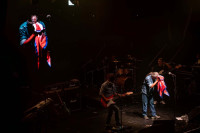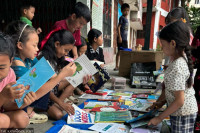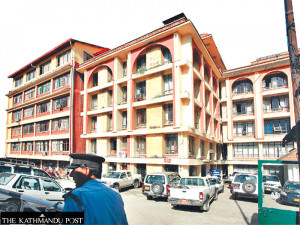Entertainment
Three Pieces for Patan
Dutch artist Bart Drost’s installations at the Kathmandu Contemporary Arts Centre are currently open to public viewing
Rachana Chettri
This is the kind of energy that the Dutch artist Bart Drost, whose Three Pieces for Patan is currently on exhibit at the KCAC vicinity—at the back garden of the Patan Museum—captures in the pencil drawings he created during his stay
at the KCAC premises. Arranged in identical picture frames hung over the exhibition space’s white walls, the pictures are an assortment of squiggly lines—forms the artist calls ‘wavies’—that seem to repeat themselves again and again until the whole of the rectangular room has been circumambulated. From here, there is only a child’s head—wrought in gold and placed atop a brick-and-cement column—to gaze at. There are two Tibetan-style ‘windows’ from where viewers can choose to look into the vast outside (or inside), but the sense of being locked in someone’s room, Drost’s room, never leaves one. The ‘wavies’ are Drost’s message to the onlooker,
the outsider, little coded scripts, messages from a dream world that befuddle you; repetitive symbols
that represent movement and music.
These squiggles appear again—not miniscule drawings in pencil this time around—in Drost’s What if God is one of us? A raised platform that is the base of the artist’s ‘home’—the bamboo construction My House My Temple—in Patan, a place he knew he would love the moment he saw a photograph of it on the Internet, has large blue ‘wavies’ one can walk over and look down at. One can follow the same process one did inside the exhibition space and follow the lines only to arrive at the house’s centre: a table with replicas of the same child’s head spread all over it. Grey and stone-like and eerily abundant, these heads are symbols of childhood for Drost, a stage most people, he believes, hurry past in the race to adulthood. Three Pieces for Patan represents a yearning for childhood in this sense, but it is also, mostly, a representation of the universality of human existence: ‘underneath our clothes...every man houses a child,’ writes Drost, and his ‘childness’ is perhaps what he is giving voice to as he, an artist from the Netherlands builds a home in Patan Durbar Square.
Today is the final day of the exhibition




 19.42°C Kathmandu
19.42°C Kathmandu












